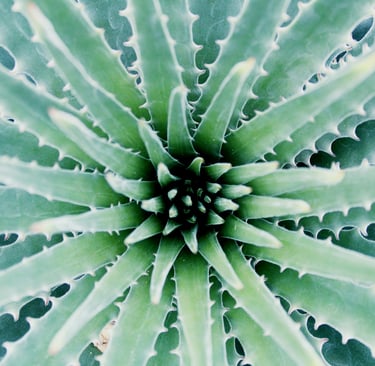

Whether you live in a cold-weather climate or the hot Sonoran desert, you've most likely heard of the aloe vera plant. It is a hardy succulent that favors poor soil, hot weather, and just a little bit of water. By God's beautiful design, aloe vera comes in 500-600 different varieties, and contains some surprising benefits. Let's dive in!
Wound Healing
Probably the most well-known benefit of aloe vera is its ability to heal cuts and burns quickly. It naturally boosts your body's own ability to regenerate cells and tissue without any side effects. You can buy aloe vera gel in the sunscreen or cosmetic aisle, or online at Amazon. If you'd like to keep an aloe vera plant but don't have a green thumb, good news--they are VERY easy to maintain! Having your own plant lets you control what you're putting on your body and can save you money. This is extremely handy for fall and winter baking!
Digestive Health
In the beverage aisle you might find aloe vera juice, a popular wellness drink that promotes heart and gut health. Keep in mind that aloe is a strong laxative, and can actually cause some digestive discomfort if consumed in high quantities.
Air Purifier
Much like the snake plant and other indoor plants, this spiky star of the show will help remove toxins like formaldehyde and benzene from the air in your home. All it asks for in return is an occasional watering and a sunny window!
Anti-inflammatory Properties
In addition to cleaning the air around you, aloe can also keep inflammation at bay in your body when taken internally. Its topical skin applications also fall under this category as it soothes irritated skin (as long as you aren't allergic to it).
Natural Laxative
Having trouble on the toilet? Aloe vera juice can help! Try drinking a little bit at a time until you notice a change in your bathroom routine so that you can keep things moving.
Cautions
Don't use aloe vera if you're allergic to it or any plants in the lily family.
Use caution if you are taking certain medications, as they can interact with them.
Avoid drinking too much aloe juice, as it is a powerful laxative that can cause digestive discomfort and abdominal pain in high doses.
How to Care for Aloe Vera
Although you might need variety-specific instructions for your plant, I will give you some general tips you can follow to take care of your aloe vera plant. Like many other types of succulents, aloe is a very resilient desert shrub that doesn't need a lot of water to thrive. If you're growing it outdoors, water it some time after the soil is completely dry, but probably no more than 2 times a month. If it's starting to wilt and look juicy and squishy, decrease the amount of water you are giving it. Succulents can store water inside their leaves for a lot of rainy days--or a lack thereof!
If you'd rather grow this succulent indoors, be sure to set it by a sunny window sill so it can have plenty of sunlight. You may need to water it even less often than if it was outdoors, because indoor temperatures are usually much cooler than those outside (especially if you live in southern Arizona).
This spunky little plant really doesn't need much care at all, which is what makes it such a wonderful plant to have on hand!
How to Harvest Aloe Vera
Choose a leaf that looks healthy and green, with no brown spots or signs of decay. Cut it with sharp scissors right at its base, where it connects to the rest of the plant.
To get to the gel, make an incision on the flat side of the aloe leaf, just deep enough to break the skin. Then repeat twice, creating slices in the shape of a capital "I."
When you pull the two flaps back, you will be able to scrape out the gel and use it topically as needed.
If you don't use all of it in one sitting, you can wrap the aloe leaf in a paper towel and put it in the fridge for up to a day.
